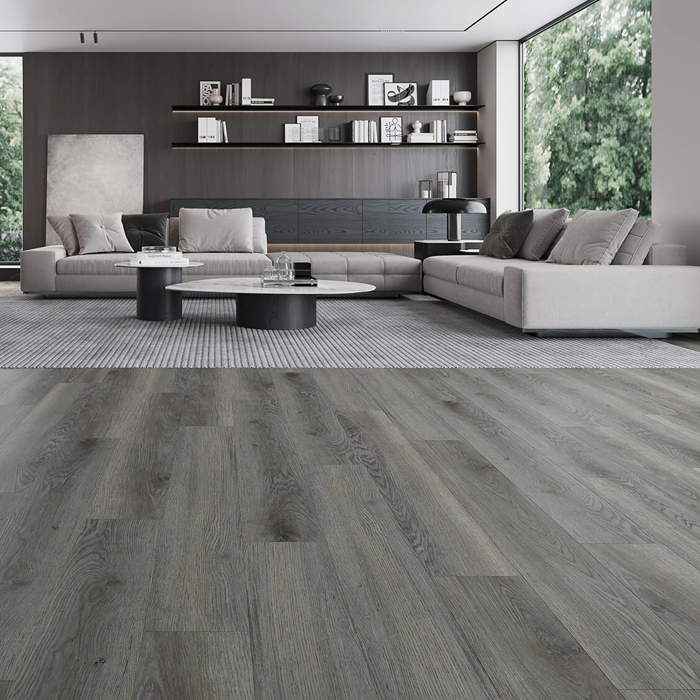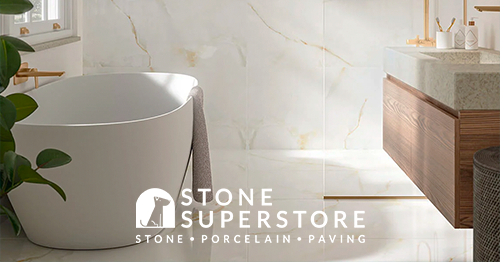When it comes to upgrading the floors in your home, it’s safe to say that there are plenty of tiling options to choose between. From natural stone to porcelain-effect, and even ceramic designs, it’s never been easier to find an aesthetic to suit you. However, tiling materials can be an investment, especially if you’re thinking of tiling a large area, which is why you might want to consider using LVT floor tiles or laminate flooring instead.
Quick to install and ideal for anyone redecorating on a tight budget, in many ways, LVT and laminate come with some unique advantages over more traditional tiling options. But what exactly sets these two materials apart?
Keep reading our guide to learn more about LVT vs laminate floors, their pros and cons, and which of these two tiling options is best suited for your current tiling project.

Meribel Walnut Click Luxury Click Tile
What is the difference between LVT and laminate?
You might assume that LVT and laminate are constructed out of the same material. But, while similar in appearance, they’re actually created using two different methods, hence the distinction between them.
For example, LVT (luxury vinyl tiles) are thicker tiles formed from a hardened, yet flexible PVC plastic core. This core is then covered by a photographic top layer that mimics a specific material, before being coated in a scratch-resistant coating to protect the tile from daily wear and tear.
Laminate, on the other hand, is made using recycled wood pulp that is compressed together under extreme pressure to form solid planks and tiles. Said planks are also coated in a scratch-resistant shield, giving laminate its characteristic sheen, while also allowing them to act as a durable replacement for typical wooden flooring.
Choosing between laminate vs LVT
Although LVT and laminate are constructed differently, you’re probably already aware that both can be used in similar areas of the home. And this begs the question, why might you choose one material over the other?
Well, as we’ve highlighted below, when it comes to laminate vs LVT, each has its own set of pros and cons that you’ll want to be aware of before picking:
What are the advantages of LVT flooring?
To examine the differences between LVT and laminate floors, let’s first look at the advantages LVT flooring can bring to your home:
Durability – LVT is a highly durable material, being both scratch-resistant and toughened against daily use.
Replaceable – If you do need to replace an LVT tile, this can be easily done, as LVT flooring is made of individual pieces rather than one solid sheet, so you won’t need to take the entire floor up to change out a single segment.
Comfort – even though LVT is hardened in order to provide strength, it’s also fairly soft underfoot for a more comfortable experience.
Waterproof – unlike many other tiling materials, LVT is waterproof, making it perfect for use in bathrooms and kitchens where splashes are present.
Insulate – thanks to the nature of their construction, LVT is naturally insulative, helping to keep home cosy. It can even be used in tandem with underfloor heating if you want truly heated floors.
Style versatility – as we’ve already mentioned, LVT can mimic any material thanks to the photographic layer sat beneath its clear protective seal, meaning you can have a floor that displays practically any surface you want.
Simple installation - Depending on your floor, LVT tiling will need to be either glued to the ground directly or locked in place using a floating floor installation set-up. Click LVT makes installation simple, quick and straightforward, ideal for DIY projects.
What are the disadvantages of LVT?
Despite LVT having many great features you can take advantage of; it does come with a few disadvantages that may make laminate the more suitable option:
Glue-down installation – Although click LVT is straightforward, with glue-down LVT, you may find you need the aid of an expert to lay your LVT for you for a flawless, straight finish.
Price – due to the nature of its advanced design, LVT flooring does tend to be more expensive than laminate over larger areas.
Low heat resistance – although LVT is by no means susceptible to warping under normal temperatures, should the room in question get higher than 27 degrees, you may find your floor becoming uneven or even peeling in certain places. As a result, LVT is widely seen as being better suited for use in colder-mid temperature environments.
What are the advantages of laminate flooring?
Much like LVT, laminate flooring has its own set of advantages to hand which could make it your preferred flooring choice:
Durability – like LVT, laminate is a very durable flooring material, able to resist both scratches and dents, and it’s also coated in a protective layer that grants it further protection against damage.
Natural feel – being it’s made from wood, you can achieve a more natural feel underfoot than you do with LVT.
Easily installation – all laminate floors are built using what’s known as a floating installation method. This means that the laminate planks or tiles are connected in an interlocking manner on top of an insulative sheet, making them both easy to lay and replace when needed as it requires no glue or nails.
Price – as we’ve already mentioned, laminate is generally considered to be cheaper to put down than LVT in most scenarios.
Heat resistance – thanks to the thickness of laminate planks, it has a much greater degree of heat resistance than LVT, so it won’t be in danger of warpage in warmer spaces. And much like LVT, this means that laminate can be used in tandem with underfloor heating.
Sustainability – laminate flooring is certainly one of the more eco-friendly flooring options available, as it’s made from recycled wood pulp. So, if you want a floor that’s good for the planet, laminate is an excellent choice.
What are the disadvantages of laminate flooring?
Even though there’s a lot to like about laminate flooring, it has several core disadvantages that can make it less suitable for use when compared to LVT:
Poor water resistance – due to how laminate is constructed, most versions are not innately waterproof. This makes laminate a poor flooring option if you’re looking to refloor a bathroom or kitchen.
Single coating – eventually, you may find you need to replace any laminate tiling after a few years as you can’t simply recoat its protective layer in the same way as with LVT flooring, giving them a shorter shelf-life.
Weak insulation – again, because of the way laminate is made, it tends to suffer from the same insulation issues as thin wooden flooring, making it essential to have underfloor heating installed along with it if you want to avoid a chill underfoot.
Limited designs – while LVT is constructed to be able to impersonate any form of style you want; laminate tends to be restricted to solely wood and stone. This is because it lacks the photographic layer found in LVT that grants it greater style versatility.
Prone to chipping – as laminate is made using wood pulp, it is prone to chipping. Naturally, this can be filled in using the right sealant, however, this is not always an ideal solution.
Choose your new tiles with Stone Superstore
Those are the main differences between LVT and laminate flooring. Hopefully, you’ll now have a better idea of which type of flooring material you’re after, but if you're wanting new kitchen tiles or bathroom floors, we believe LVT reigns supreme.
Of course, here at Stone Superstore, LVT isn’t our only tiling option. In fact, we have a whole range of materials for you to browse right here on our website!
Get in touch to learn more about just what our tiles are capable of, and don’t forget to order your free tile samples from our warehouse when you’ve settled on your choice.

Aspen Grey Click Luxury Vinyl Tile
FAQs
Is LVT warmer than laminate flooring
Yes, in most cases, LVT will be warmer underfoot than laminate flooring. This is because LVT has naturally better insulation, allowing it to retain heat more effectively than laminate’s wooden construction.
Is LVT waterproof?
LVT flooring is suitable is any room of the home, including those areas prone to splashes. They are water resistant and even suitable for use in bathrooms - however we wouldn’t recommend using LVT in showers, saunas or outdoors, where continued exposure to moisture could lead to water getting trapped under the tiles.

